What People are Commenting
Sorrows of Mary, Active Participation & FSSP
Why Did Pius X Not Stop the Abuses on Active Participation?
Dear Dr. Byrne,
I have begun to read your sequence of articles on the Dialogue Mass which are posted on the Tradition in Action website.
Let me thank you for the depth of your research and the clarity of your presentation of what is a sad, and indeed shocking, story.
Two questions have arisen which I hope I may put to you:
1. You write of Tra le sollecitudine that the definitive Latin version differs from the Vernacular translations in that the qualifier 'active' for participation is not found there. Is it not the case that the text was drafted originally in Italian? If so, 'active participation' may well have reflected the Pope's wishes. Also, you do not address the lack of reaction of Pius X to the abuse of his Motu Proprio. Given that he seems to have made no attempt to stop the very wide interpretation given to it by Beauduin and others, must we not assume that he was complicit, if not in full agreement with the 'reformers'?
2. You write in Note 4 to Part IX of your series: "Even as early as 1914, at the Benedictine Abbey of Maria Laach in Germany, Abbot Herwegen had celebrated the Dialogue Mass in German." Do you have a source for this claim?
I hope very much that this mail reaches you and that you will be able to reply to it.
With very best wishes,
E.K.
Dr. Byrne responds:
Dear Mr. E.K.,
Thank you for your kind words about the presentation of my articles on TIA and for your enquiry.
1. The question is often presented as a chicken and egg situation: Which comes first, the Italian or the Latin version? But, in my opinion, it is not the chronology that matters but the authoritative nature of the documents. It may be useful to reiterate that, once a magisterial document is published in Latin, there is no alternative interpretation in vernacular versions that carries equal validity, irrespective of the dates of promulgation. That is because the document must be able to refer to and develop the formulations of earlier Latin documents without misleading or confusing the faithful through the ever-changing forms of the vernacular.
If “active participation” was the Pope’s wish for the laity, he never mentioned it in any Latin document before or during his papacy. Besides, the very idea clashes with the rest of his motu proprio in which he designates the clergy as the only singers of Gregorian Chant, and describes the laity as “listeners” to their performance of it.
Also, if the Italian version is the correct one, the Latin version must be defective because there are many discrepancies between them, as I have shown in my articles. But to accept the vernacular over the Latin would be to undermine the transmission of the Faith which is expressed in Latin as the ultimate safeguard of the truth.
All this, and more, is laid out in greater detail in my recently published book, Born of Revolution: a Misconceived Liturgical Movement (Holyrood Press, 2020).
IIn the book I also address the fact that the Holy See allowed some Bishops to bypass the regulations as early as 1908 (see p. 61). However, I do not think we can assume that Pius X was complicit in any disobedience of his orders, as it was the responsibility of the Bishops to enforce his legislation according to Canon 1261. Most, I think, complied.
2. Regarding Abbot Herwegen and the use of the vernacular in 1914, I did have a reference for it – otherwise I would not have made the assertion – but unfortunately it went missing before I had a chance to include it. If I come across it again, I will send it to you.
Yours sincerely,
Carol Byrne
I have begun to read your sequence of articles on the Dialogue Mass which are posted on the Tradition in Action website.
Let me thank you for the depth of your research and the clarity of your presentation of what is a sad, and indeed shocking, story.
Two questions have arisen which I hope I may put to you:
1. You write of Tra le sollecitudine that the definitive Latin version differs from the Vernacular translations in that the qualifier 'active' for participation is not found there. Is it not the case that the text was drafted originally in Italian? If so, 'active participation' may well have reflected the Pope's wishes. Also, you do not address the lack of reaction of Pius X to the abuse of his Motu Proprio. Given that he seems to have made no attempt to stop the very wide interpretation given to it by Beauduin and others, must we not assume that he was complicit, if not in full agreement with the 'reformers'?
2. You write in Note 4 to Part IX of your series: "Even as early as 1914, at the Benedictine Abbey of Maria Laach in Germany, Abbot Herwegen had celebrated the Dialogue Mass in German." Do you have a source for this claim?
I hope very much that this mail reaches you and that you will be able to reply to it.
With very best wishes,
E.K.
______________________
Dr. Byrne responds:
Dear Mr. E.K.,
Thank you for your kind words about the presentation of my articles on TIA and for your enquiry.
1. The question is often presented as a chicken and egg situation: Which comes first, the Italian or the Latin version? But, in my opinion, it is not the chronology that matters but the authoritative nature of the documents. It may be useful to reiterate that, once a magisterial document is published in Latin, there is no alternative interpretation in vernacular versions that carries equal validity, irrespective of the dates of promulgation. That is because the document must be able to refer to and develop the formulations of earlier Latin documents without misleading or confusing the faithful through the ever-changing forms of the vernacular.
If “active participation” was the Pope’s wish for the laity, he never mentioned it in any Latin document before or during his papacy. Besides, the very idea clashes with the rest of his motu proprio in which he designates the clergy as the only singers of Gregorian Chant, and describes the laity as “listeners” to their performance of it.
Also, if the Italian version is the correct one, the Latin version must be defective because there are many discrepancies between them, as I have shown in my articles. But to accept the vernacular over the Latin would be to undermine the transmission of the Faith which is expressed in Latin as the ultimate safeguard of the truth.
All this, and more, is laid out in greater detail in my recently published book, Born of Revolution: a Misconceived Liturgical Movement (Holyrood Press, 2020).
IIn the book I also address the fact that the Holy See allowed some Bishops to bypass the regulations as early as 1908 (see p. 61). However, I do not think we can assume that Pius X was complicit in any disobedience of his orders, as it was the responsibility of the Bishops to enforce his legislation according to Canon 1261. Most, I think, complied.
2. Regarding Abbot Herwegen and the use of the vernacular in 1914, I did have a reference for it – otherwise I would not have made the assertion – but unfortunately it went missing before I had a chance to include it. If I come across it again, I will send it to you.
Yours sincerely,
Carol Byrne
______________________
FSSP Compromise Confirmed
Note from the Editor: At TIA we have always affirmed that Fraternity St. Peter (FSSP) accepted Vatican II and the New Mass; otherwise, its priests would have never received permission from the local Bishops to establish their churches and exercise their ministry.
Close friends of the heads of FSSP have demanded that we prove this, which we did only indirectly with the previous argument, since we did not have material proof to demonstrate it directly.
On July 20, 2021, the head of the FSSP in Fribourg, Switzerland, issued an official document on the Motu proprio Traditionis custodes offering formal and indisputable evidence that FSSP had accepted Vatican II since the beginning of its existence.
We still await the direct proof, which would support many testimonies, that the organization accepted the New Mass, even while adopting the 1962 Missal.
We reproduce below a snapshot of the official document from its website, which can be seen here.
A.S.G.
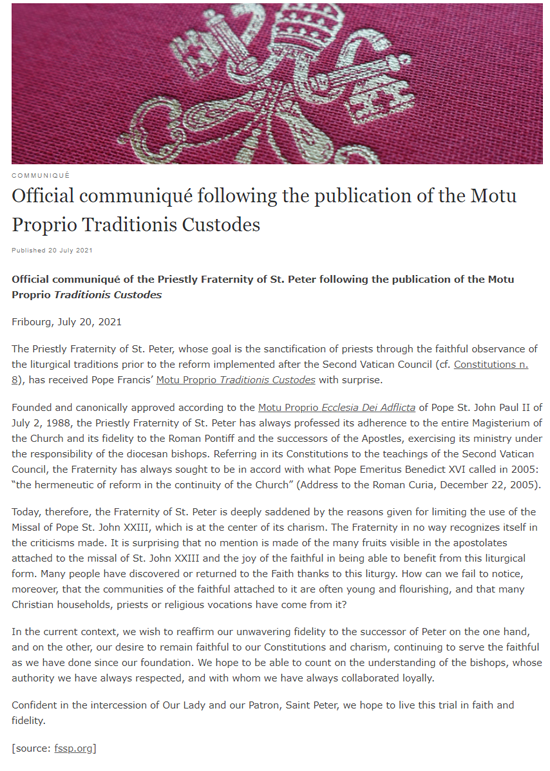
Close friends of the heads of FSSP have demanded that we prove this, which we did only indirectly with the previous argument, since we did not have material proof to demonstrate it directly.
On July 20, 2021, the head of the FSSP in Fribourg, Switzerland, issued an official document on the Motu proprio Traditionis custodes offering formal and indisputable evidence that FSSP had accepted Vatican II since the beginning of its existence.
We still await the direct proof, which would support many testimonies, that the organization accepted the New Mass, even while adopting the 1962 Missal.
We reproduce below a snapshot of the official document from its website, which can be seen here.
A.S.G.

For a larger text, click here

Posted July 22, 2021
______________________
The opinions expressed in this section - What People Are Commenting - do not necessarily express those of TIA
______________________
______________________












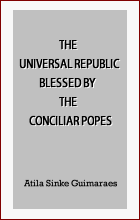
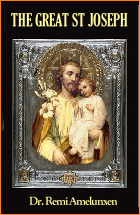
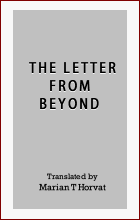



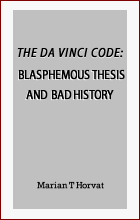
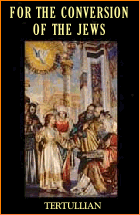
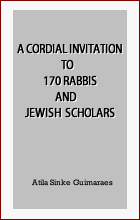
Re: Precious Blood
Responding to your request to bring the texts of Maria de Agreda in which she affirmed Our Lady suffered in her body the pains of the Passion, please see the following from Mistica Ciudad de Dios Vida de Maria (Madrid: Edicion 1970, Reimpresion 1992).
Pero ya he dicho en otros lugares de esta Historia, y más en el discurso de la pasión del Señor, que sintió María santísima en su cuerpo todos los dolores que con las heridas sentía y recibía el Hijo.
In English, from City of God, The Transfixion (Translation by Fiscar Marison, 1971 Ave Maria Institute).
I have already mentioned in other places of this history, and especially in that of the Passion, that the blessed Mother felt in her own body all the torments of her Son.
I have attached scans of each.
P.C.
TIA responds:
Dear P.C.,
Thank you for sending us the two texts of Mary of Agreda (Mystical City of God) with the translations in both Spanish and English.
You were correct about her affirmation that Our Lady "felt in her body all the wounds that her Son felt and received."
We continue to believe that this is a way used by Mary of Agreda to express the moral sorrows of Our Lady.
Indeed, when any person feels moral pain for the physical suffering of another, his body is also affected since he may shed tears, have convulsions or even faint. Moral pain implies a corporal suffering as well.
We do not believe that Our Lady suffered the same physical pains as Our Lord, as you defend. Otherwise, she would have bled from all the tortures He suffered and, finally, would have died when He expired on the Cross.
Cordially,
TIA correspondence desk